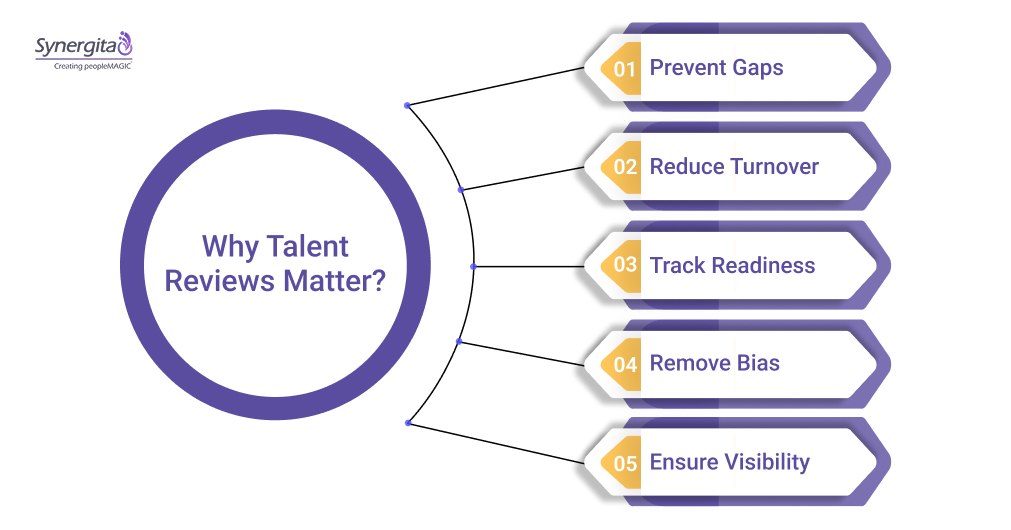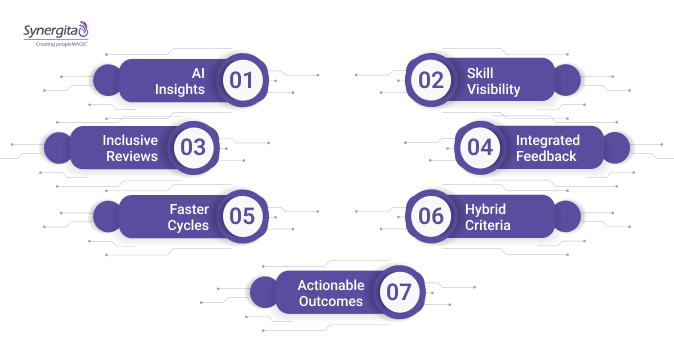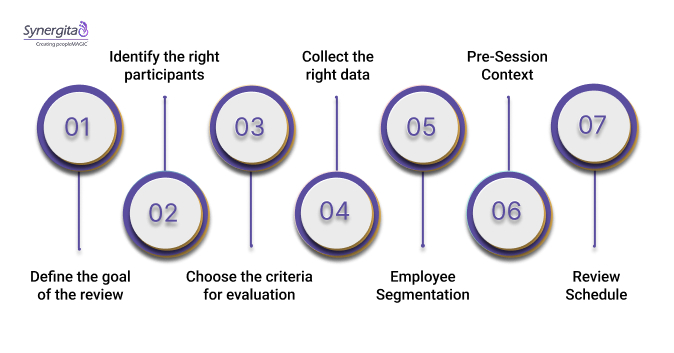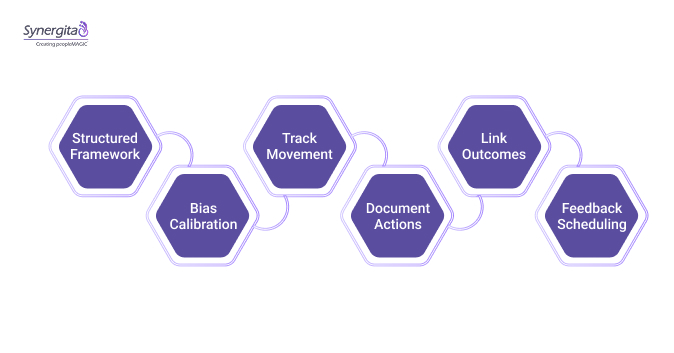Organizations that prioritize their people’s performance are 4.2 times more likely to outperform their peers, achieving approximately 30 percent higher revenue growth and experiencing 5 percentage points lower attrition rates. In 2025, this is no longer optional. Rapid shifts in technology, workforce expectations, and organizational priorities have pushed talent reviews into the spotlight. Unlike annual performance reviews that focus on individual past performance, talent reviews take a broader view of readiness, growth, and long-term business continuity.
They help answer key questions:
- Who is ready to lead or take on more responsibility
- Where are the talent gaps and succession risks
- What kind of development is needed to close those gaps
This guide will walk through the essential steps for running an effective talent review, the tools and frameworks that work in 2025, and how leading companies are turning these insights into action.
Key Takeaways:
- Talent reviews go beyond performance scores to assess future leadership and readiness
- Companies that invest in them see faster growth and stronger retention
- AI and real-time insights are transforming how potential is spotted and developed
- Reviews now happen more often and include a broader, more diverse set of employees
- Success depends on structured preparation, calibrated discussion, and clear action steps
- The best reviews spark development, not just decisions
What Is a Talent Review and How Does It Differ from a Performance Review
A talent review is a forward-looking process that evaluates an employee’s potential, development readiness, and future fit in the organization. In contrast, a performance review focuses on assessing past performance against defined goals in the current role.
While performance reviews are often conducted by individual managers, talent reviews bring together HR, leadership, and cross-functional stakeholders. The goal is to align on succession planning, leadership readiness, and development investment.
Here’s a side-by-side comparison to show how they differ:
| Aspect | Talent Review | Performance Review |
| Focus | Future potential and readiness for advancement | Past performance in the current role |
| Participants | HR leaders, senior managers, cross-functional input | Employee and direct manager |
| Purpose | Succession planning, identifying high potentials | Evaluating achievements and setting goals |
| Scope | Organization-wide or team-wide strategic assessment | Individual performance snapshot |
| Data Sources | 9-box grid, peer input, skill gap analysis | Goal tracking, KPI scores, self and manager ratings |
| Outcome | Development plans, promotions, talent mobility | Compensation decisions, feedback, goal updates |
Talent reviews are not meant to replace performance reviews. They complement each other. Together, they help organizations retain top performers, prepare for leadership gaps, and invest in the right development programs.
Why Talent Reviews Matter Even More in 2025
In today’s tight labor market rapid technology shifts and rising employee expectations, relying solely on annual performance reviews is insufficient. Talent reviews give you the strategic insight to identify risk areas, plan for succession and foster growth across the organization.
Mercer reports that only 12 percent of companies feel confident in the strength of their leadership pipeline which puts organizations at risk when leadership gaps emerge.
At the same time Gallup estimates that replacing a manager can cost around 200 percent of their salary and replacing technical employees can cost up to 80 percent of their salary depending on role complexity.
Talent reviews deliver critical value in multiple ways:

- Prevent leadership gaps before they create disruption: Talent reviews help identify internal successors early rather than resorting to external hiring after a departure occurs.
- Reduce high-cost turnover: By identifying high-potential employees and offering tailored development opportunities organizations can reduce unexpected exits and avoid replacement expenses that range from 50 to 200 percent of annual salary.
- Track readiness amid shifting business needs: With quarterly changes in business strategy talent reviews allow you to realign workforce capability and agility before gaps appear.
- Remove bias and increase diversity in talent decisions: Structured reviews using calibrated inputs like peer feedback and panel assessments reduce the risk of advancing the wrong candidates and improve fairness across leadership pipelines.
- Ensure visibility in hybrid and distributed work environments: Central review sessions ensure high performers and high potentials aren’t overlooked simply because they’re remote or less vocal in meetings.
In short, talent reviews are a strategic lever for future-proofing your workforce, making leadership continuity possible and avoiding costly disruptions.
Emerging Talent Review Trends to Watch in 2025

Talent reviews are no longer confined to HR checklists or leadership summits. The way organizations approach them is evolving to keep up with a changing workforce, smarter tools and rising expectations from both employees and business leaders.
- AI-powered insights for better decisions: Many organizations are turning to AI to surface patterns that human reviewers may miss. Predictive analytics can highlight employees at risk of leaving, those ready for the next step and potential successors based on skill graphs and performance trajectories.
- Skill-gap visibility at a team and org level: Rather than focusing on past performance alone, leading platforms now map current skills against future requirements. This shift helps organizations not only fill gaps but also shape upskilling and reskilling plans in line with strategic goals.
- Greater inclusion in reviews: Talent reviews are expanding beyond senior roles. Organizations are now applying structured assessments to mid-level and frontline teams, ensuring that development opportunities reach high performers throughout the workforce.
- Integrated feedback sources: In 2025, effective talent reviews use multiple inputs, from self-assessments and peer reviews to engagement data and pulse surveys. This makes decisions more balanced and less dependent on the manager’s perception alone.
- Review cycles are getting shorter: Instead of annual reviews, many companies are shifting to quarterly or biannual talent reviews. This allows them to respond faster to role changes, team movements and market conditions.
- Remote and hybrid-specific criteria: With hybrid work as the norm, companies are updating their review frameworks to avoid visibility bias. Leadership potential is now assessed using outcomes, collaboration scores and initiative-taking rather than physical presence.
- Connection with learning and mobility tools: The best talent reviews in 2025 do not stop at identification. They are linked directly to internal mobility platforms and learning paths, so action can begin as soon as a review ends.
These trends show that talent reviews are becoming more data-rich, inclusive and tightly integrated with broader talent development strategies. The organizations that succeed will be the ones that treat talent reviews as a living process, not a static formality.
How to Prepare for a Talent Review That Delivers Results

The success of a talent review depends heavily on what happens before the meeting begins. Without a clear objective, reliable data, and the right stakeholders in the room, reviews can become a discussion of opinions rather than a strategic assessment of potential. Here’s how to prepare for a review that drives real outcomes.
1. Define the goal of the review
Start by answering why the talent review is being conducted now. Are you planning for succession in key roles, looking to build a pipeline of future leaders, or responding to changing business needs? Align the review objective with the organization’s current priorities.
2. Identify the right participants
A cross-functional panel creates a more balanced view. Include HR leaders, department heads, and managers who have day-to-day visibility into employee performance and behavior. In some cases, senior leadership may also participate to align decisions with long-term planning.
3. Choose the criteria for evaluation
Standardize how potential and performance will be assessed. Common dimensions include problem-solving ability, learning agility, collaboration, leadership potential, and cultural alignment. Using a shared framework ensures that everyone evaluates talent based on the same expectations.
4. Collect the right data
Relying solely on manager opinions introduces bias. Use a mix of inputs such as:
- Recent performance ratings
- Peer and 360-degree feedback
- Career aspirations from employee surveys
- Engagement scores
- Managerial notes or coaching records
- Skills inventory or certification data
5. Segment employees to review
It may not be feasible to review everyone at once. Prioritize by function, seniority, or business criticality. Some organizations begin with high-impact teams or departments undergoing structural change.
6. Provide context ahead of the session
Distribute pre-read materials to panel members. This includes talent summaries, skill matrices, and performance snapshots. This step ensures that time in the review is spent on discussion and decision-making rather than catching up on context.
7. Set a review cadence and timeline
Clarify when the review will take place, how long it will last, and what happens afterward. Set expectations for post-review actions like development planning or one-on-one conversations with employees.
With these steps in place, the talent review becomes a focused exercise that not only identifies top talent but also lays the groundwork for development and succession strategies.

How to Conduct a Talent Review That Drives Action

Once the groundwork is done, the focus shifts to execution. A well-run talent review isn’t just a meeting, it’s a structured decision-making session that turns raw data into people strategies. Here’s how to make the most of the session itself.
1. Use a structured framework like the 9-box grid
The 9-box grid is one of the most widely used tools for evaluating employees based on two dimensions: current performance and future potential. It helps reviewers identify high-potential, high-performing talent and spotlight those needing more support or development.
Here’s how the matrix typically looks:
| Potential \ Performance | Low | Moderate | High |
| High | Growth risk | Emerging star | Future leader |
| Moderate | Solid player | Core contributor | High potential |
| Low | Underperformer | Inconsistent | Current strength |
Employees falling into the top-right (future leader) and middle-top (emerging star) blocks are often prioritized for succession and leadership tracks. Those in the center (core contributors) are strong performers who may benefit from targeted development. And the bottom-left quadrant signals either a misfit or a need for serious intervention.
2. Calibrate the discussion to remove bias
Run the session as a calibration meeting. Instead of each manager presenting their views in isolation, invite open discussion and ask panelists to challenge or validate each other’s ratings. This prevents overrating based on personal rapport or underrating due to isolated incidents.
3. Focus on movement, not just labels
The goal is not to categorize employees but to define what comes next for them. Every review should answer: What is the next best step for this person? Options could include mentoring, job rotation, formal training, or stretch assignments.
4. Document actions clearly
Summarize the review outcomes in a format that includes:
- Development plans for each talent segment
- Succession pipeline updates
- Identified skill gaps at individual and team levels
- Suggested follow-ups (like skip-level meetings or coaching sessions)
5. Link outcomes to talent systems
Feed the results into connected systems like your learning management platform or internal mobility dashboard. This ensures actions move forward without delay.
6. Schedule feedback conversations
One of the biggest gaps post-review is poor communication. Ensure that managers are aligned on how to deliver feedback to employees and how to frame development plans as opportunities rather than judgment.
Done right, the talent review becomes a launchpad for meaningful development, not a one-off ratings exercise.
How Synergita Supports Talent Reviews
Synergita offers an end-to-end platform that enables HR leaders and managers to plan, conduct, and follow through on talent reviews with precision. Built to handle the complexity of real-world organizations, it turns fragmented processes into streamlined workflows.
- Centralized talent profiles: Synergita aggregates employee data from performance reviews, feedback cycles, learning progress, and engagement scores into one unified profile. This ensures that every discussion is informed and grounded in current, comprehensive insights.
- Visual tools for strategic assessments: The platform comes equipped with interactive tools like the 9 box grid, readiness charts, and talent heatmaps. These visualizations help stakeholders spot trends, succession gaps, and high potential employees quickly across teams or departments.
- Customizable evaluation frameworks: Organizations can define their own talent dimensions such as learning agility, leadership readiness, innovation, or collaboration and rate employees against these with a consistent rubric. This flexibility makes the platform adaptable across functions, industries, and geographies.
- Built-in collaboration for panel discussions: Synergita makes it easy to run cross functional talent reviews. Multiple reviewers can provide feedback, view prior inputs, and calibrate decisions during the session. Automated workflows guide users through the review cycle and ensure decisions are recorded and traceable.
- Action planning that doesn’t get lost: Outcomes from talent reviews such as promotions, lateral moves, mentoring, or development tracks can be assigned directly within the platform. Managers can track progress, set reminders, and ensure follow through without relying on disconnected spreadsheets or emails.
- Integration with learning and mobility platforms: Synergita integrates with internal learning management systems and job mobility tools so employees marked for development can immediately be enrolled in learning paths or added to future fit pipelines.
- Real-time analytics and leadership insights: Post review dashboards offer leadership teams a view into succession readiness, diversity metrics, retention risk, and capability gaps. Filters by location, role, tenure, or skill allow deeper insight into strategic workforce planning.
Click here to schedule a demo!
Conclusion
Most companies talk about building future-ready teams. Few actually know where their next wave of leaders is coming from. Fewer still have a plan to get them ready.
Talent reviews are where intent meets action. When done right, they reveal hidden strengths, surface gaps you didn’t know existed, and give your best people a reason to stay and grow.
But the real difference is in execution. Do you have a system that brings clarity to the chaos? One that helps you make smarter decisions without slowing down?
Synergita gives you that edge. With built-in frameworks, role-based views, and seamless integration with your performance and learning workflows, you don’t just review talent. You build momentum.
Let your next review be more than a meeting. Let it be the moment your people strategy got real.
Explore Synergita’s Talent Review capabilities today

Frequently Asked Questions
Q: What happens in a talent review?
A: A talent review is a structured meeting where leaders evaluate employees’ future potential, performance, and readiness for growth. It typically includes data from performance reviews, peer feedback, and skill assessments. The goal is to align on who’s ready for promotion, who needs development, and where succession gaps exist.
Q: What are the benefits of talent reviews?
A: Talent reviews help organizations:
- Identify and retain high-potential employees
- Plan succession for critical roles
- Reduce costly turnover
- Improve diversity in leadership pipelines
- Align development investments with business goals
Q: What are the four key components of a talent review?
A: Objective setting – Clarify the purpose of the review
Evaluation framework – Use criteria like learning agility, collaboration, and leadership potential
Data collection – Pull insights from performance ratings, feedback, skills, and goals
Action planning – Define next steps like promotions, mentoring, or development programs
Q: What to do after a talent review?
A: Follow up with clear communication and next steps for each employee. Update development plans, schedule one-on-one feedback sessions, and link review outcomes to learning or mobility tools. Track progress and revisit outcomes in future reviews.
Q: What is the scorecard for talent review?
A: A talent review scorecard summarizes individual employee assessments based on criteria like potential, performance, and readiness. It can include ratings, reviewer comments, and recommended actions, helping leaders quickly compare and make informed decisions.
Q: What does talent review mean on a job application?
A: If you see “talent review” on a job application, it may refer to a stage in the hiring process where internal stakeholders evaluate whether a candidate aligns with future leadership potential or strategic growth needs. It’s often used when hiring for critical or leadership-track roles.


